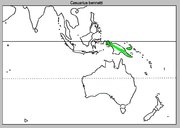Cassowary
|
|
| Cassowaries | ||||||||||||
|---|---|---|---|---|---|---|---|---|---|---|---|---|
| Missing image Kasuaris.jpg Southern Cassowary Southern Cassowary | ||||||||||||
| Scientific classification | ||||||||||||
| ||||||||||||
| Species | ||||||||||||
|
Casuarius casuarius |
Cassowaries (genus Casuarius) are very large flightless birds native to the tropical forests of New Guinea and north eastern Australia. Some nearby islands also have small cassowary populations: it is not known if these are natural or the result of the trade in young birds carried on by the peoples of New Guinea. They are frugivorous; fallen fruit and fruit on low branches is the mainstay of their diet. They also eat fungi, snails, insects, frogs, snakes and other small animals. Lifespan is thought to be about 40-50 years.
Cassowaries are part of the ratite group, which also includes the Emu, rheas, Ostrich, moa, and kiwi. There are three species:
- Southern Cassowary C. casuarius of Australia and New Guinea.
- Dwarf Cassowary C. bennetti of New Guinea and New Britain.
- Northern Cassowary C. unappendiculatus of New Guinea.
Cassowary.jpg
The Northern and Dwarf Cassowaries are not well known. All cassowaries are usually shy, secretive birds of the deep forest, adept at disappearing long before a human knows they are there. On rare occasions, though, they have been known to attack humans and are capable of inflicting serious injuries on an adult human, even causing death. These instances are usually the result of provocation on behalf of the human, or due to the involvement of dogs; wounded or cornered birds are particularly dangerous. Unprovoked attacks on a village in PNG has also been documented, but was the result of a bird previously raised in captivity being released into the wild. At least two people, a man and his mother, were confirmed to have died as a result of this cassowary. Even the more accessible Southern Cassowary of the far north Queensland rain forests is not well understood.
The Southern Cassowary is the second-largest bird in Australia and the third-largest remaining bird in the world (the Ostrich and Emu are larger). "Cassowary" derives from the Malay name kesuari.
Adult Southern Cassowaries are 1.5 to 1.8 m (5½ feet) tall and weigh about 60 kilograms (130 pounds). They have a bony casque on the head that is used to batter through underbrush, making them the only armoured bird in the world. Females are bigger and more brightly coloured.
Normally cassowaries are very shy but when cornered can lash out dangerously with their powerful legs. Their three-toed feet have sharp claws; the dagger-like middle claw is 120 mm (5 inches) long. They can run up to 50 km/h (32 mph) and jump up to 1.5 m (5 feet). They are good swimmers. During WWII American and Australian troops stationed in New Guinea were warned to steer clear of the birds.
Females lay three to eight large, pale green-blue eggs in each clutch. These eggs measure about 90 by 140 mm (3½ by 5½ inches) — only ostrich and emu eggs are larger. The female does not care for the eggs or the chicks; the male incubates the eggs for two months, then cares for the brown-striped chicks for nine months.
Southern Cassowaries are a threatened species because of habitat loss; estimates of their current population range from 1500 to 10,000 individuals. About 40 are kept in captivity in Australia. Habitat loss has caused some cassowarries to venture out of the rainforest into human communities. This has caused conflict particularly with fruit growers. However, in some locations such as Mission Beach, Queensland, tourism involving the birds has been launched.
Missing image Casuariuas_casuarius_Distribuzione.jpg Distribution of Casuarius casuarius | Missing image Casuarius_unappendiculatus_Distribuzione.jpg Distribution of Casuarius unappendiculatus |
Sources
- Stay in Touch, Philip Clark (ed), The Sydney Morning Herald, 5 November 1990. Cites "authorities" for the death claim.
- Underhill D (1993) Australia's Dangerous Creatures, Reader's Digest, Sydney, New South Wales, ISBN 0-86438-018-6

